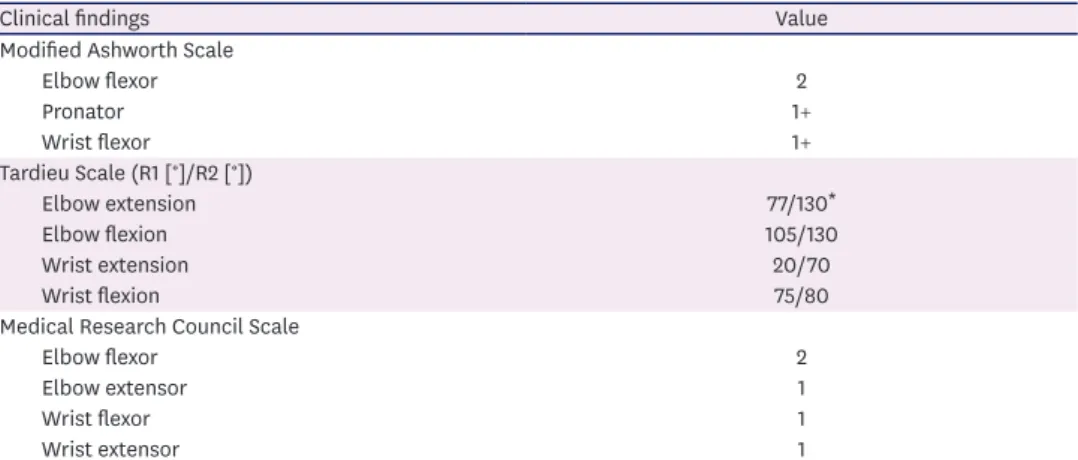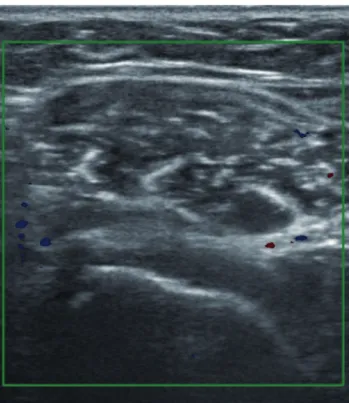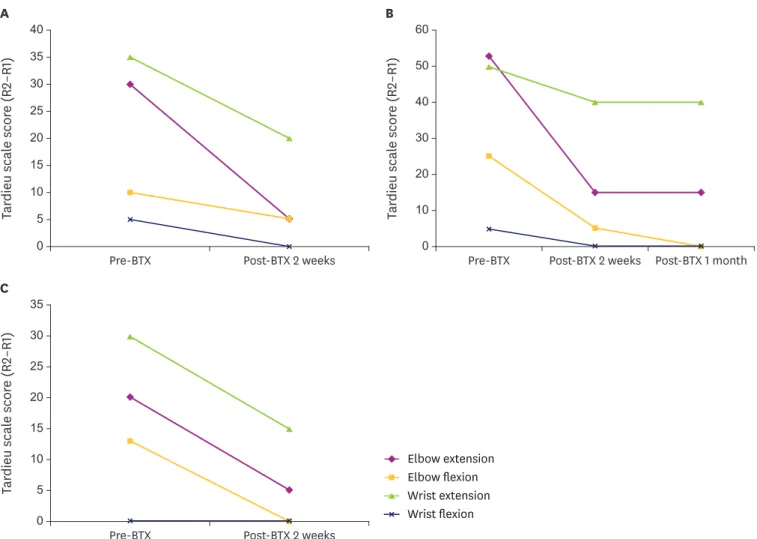HIGHLIGHTS
• Chemodenervation with botulinum toxin is effective for focal post stroke spasticity.
• Ultrasound-guided botulinum toxin injection was done with pre-procedural and post-pro- cedural factor VIII administration in a hemophilia A patient.
• After the botulinum toxin injection, spasticity improved without adverse events.
Brain Neurorehabil. 2018 Sep;11(2):e20 https://doi.org/10.12786/bn.2018.11.e20 pISSN 1976-8753·eISSN 2383-9910
Case Report
Received: May 8, 2018 Accepted: Oct 1, 2018 Correspondence to Joon-Ho Shin
Department of Rehabilitation Medicine, National Rehabilitation Center,
58 Samgaksan-ro, Gangbuk-gu, Seoul 01022, Korea.
E-mail: asfreelyas@gmail.com
Min A Shin, Stephanie Hyeyoung Lee, Jong-Min Lee, Joon-Ho Shin
Ultrasound-Guided Botulinum Toxin Injection with Factor VIII Administration for Post Stroke
Spasticity in a Hemophilia A Patient
Brain & NeuroRehabilitation
Copyright © 2018. Korea Society for Neurorehabilitation i
ABSTRACT
Chemodenervation with botulinum toxin (BTX) has been recommended for focal spasticity.
BTX injection should be performed with caution in patients with bleeding disorders and/
or receiving anticoagulation therapy. We present a case of BTX injection for post-stroke spasticity in a patient with hemophilia A who could not take oral spasmolytics due to chronic hepatitis C. To minimize the bleeding risk, we replaced factor VIII intravenously in accordance with the World Federation of Hemophilia guidelines for minor surgery. FVIII (3,000 IU) was administered 15 minutes before BTX injection. One day later, 2,000 IU was administered, and 2 days later, another 2,000 IU was administered. We performed the real-time Ultrasound-guided BTX injection three times, then spasticity and upper extremity function improved without adverse events. BTX injection can be considered as a treatment option for spasticity among patients with hemophilia.
Keywords: Botulinum Toxins; Spasticity; Stroke; Homophilia A; Ultrasound
INTRODUCTION
Spasticity results from damage of upper motor neurons, and can cause pain, joint
contracture, and restrictions to activities of daily living. Nonpharmacologic or pharmacologic treatment is available, and chemodenervation with botulinum toxin (BTX) has been
recommended for focal spasticity [1-4]. However, BTX injection should be performed with caution in patients with bleeding disorders and/or receiving anticoagulation therapy according to the United States Food and Drug Administration. We report a case of BTX injection for post-stroke spasticity in a patient with hemophilia A who could not take oral spasmolytics due to chronic hepatitis C.
CASE REPORT
A 40-year-old man diagnosed with left hemiplegia due to intracranial hemorrhage in the right putamen in September 2014 was admitted to our hospital in April 2015. He was born with hemophilia A and had received blood transfusion of clotting factor until he was 10-year- old. Then, factor VIII (FVIII) replacement therapy (2,000 IU every 4 days) was carried out
Case Report
Received: May 8, 2018 Accepted: Oct 1, 2018 Correspondence to Joon-Ho Shin
Department of Rehabilitation Medicine, National Rehabilitation Center,
58 Samgaksan-ro, Gangbuk-gu, Seoul 01022, Korea.
E-mail: asfreelyas@gmail.com
*Current address: Department of Rehabilitation Medicine, Samsung Medical Center, Sungkyunkwan University School of Medicine, Seoul, Korea.
Copyright © 2018. Korea Society for Neurorehabilitation
This is an Open Access article distributed under the terms of the Creative Commons Attribution Non-Commercial License (https://
creativecommons.org/licenses/by-nc/4.0) which permits unrestricted non-commercial use, distribution, and reproduction in any medium, provided the original work is properly cited.
ORCID iDs Min A Shin
https://orcid.org/0000-0002-1085-6000 Stephanie Hyeyoung Lee
https://orcid.org/0000-0001-9221-6121 Jong-Min Lee
https://orcid.org/0000-0001-6405-0611 Joon-Ho Shin
https://orcid.org/0000-0001-6447-8829
Min A Shin ,* Stephanie Hyeyoung Lee , Jong-Min Lee , Joon-Ho Shin
Department of Rehabilitation Medicine, National Rehabilitation Center, Seoul, Korea
Ultrasound-Guided Botulinum Toxin Injection with Factor VIII Administration for Post Stroke
Spasticity in a Hemophilia A Patient
Funding
This study was supported by a grant (No.
NRCTR–IN15002) of the Translational Research Center for Rehabilitation, National Rehabilitation Center, Ministry of Health &
Welfare, Republic of Korea.
Conflict of Interest
The authors have no potential conflicts of interest to disclose.
following the World Federation of Hemophilia (WFH) guidelines. Heterotrophic ossification occurred in right knee, left ankle, and left elbow as a result of repetitive hemarthrosis, and he had a limitation of motion of left elbow extension to 34 degrees. He also had been infected with hepatitis C virus 20 years ago, which might have been caused by transfusion of the infected clotting factor concentrates. Since then, he had been receiving regular medical follow-ups and taking oral hepatotonics.
At the time of admission, the left upper limb strength was Medical Research Council scale grade 1–2, and the spasticity was Modified Ashworth Scale (MAS) grade 1–2. The detailed clinical findings are presented in Table 1. His elbow, wrist and finger flexor spasticity induced pain and hindered rehabilitation and activities of daily living, such as bathing or dressing, thus the management of spasticity was necessary.
However, the use of oral medication for spasticity was limited as the results of repetitive liver function tests were consistently above the normal ranges (aspartate aminotransferase, up to 80 IU/L; alanine aminotransferase, up to 50 IU/L). BTX injection was also limited because of his coagulopathy. Though he wanted BTX injection for left upper limb spasticity, his previous doctors refused to perform BTX injection due to his coagulopathy. Despite fully explained bleeding risk and other possible adverse events of BTX injection, he strongly requested it.
Additionally, his spasticity was getting worse hindering rehabilitation and further functional improvement along with left upper extremity pain reaching 8/10 on a numeric rating scale.
Thus, we planned to perform BTX injection after obtaining written informed consent.
There is no guideline for BTX injection in patients with coagulopathy. To minimize the bleeding risk, we replaced FVIII intravenously in accordance with the WFH guidelines for minor surgery. FVIII (3,000 IU) was administered 15 minutes before BTX injection. One day later, 2,000 IU was administered, and 2 days later, another 2,000 IU was administered. After confirming the exact location of the target muscle and vessels, we performed the real-time US-guided injection (Accuvix XG; Medison, Seoul, Korea). Total 300 IU of Botox® (Allergan Inc., Irvine, CA, USA) was used (Table 2). US follow-up was conducted right after injection and there was no finding suggesting bleeding (Fig. 1). Blood laboratory tests including the complete blood cell count were conducted at the next day of the injection and the level of hemoglobin changed from 15.4 g/dL to 15.6 g/dL. The range of motion (ROM) and MAS grades were improved when evaluated at 2 weeks and 1 month post-injection. His affected
2/6 https://doi.org/10.12786/bn.2018.11.e20
Botulinum Toxin in Hemophilia Brain & NeuroRehabilitation
https://e-bnr.org
Table 1. Baseline clinical findings of left upper limb spasticity and muscle strength
Clinical findings Value
Modified Ashworth Scale
Elbow flexor 2
Pronator 1+
Wrist flexor 1+
Tardieu Scale (R1 [°]/R2 [°])
Elbow extension 77/130*
Elbow flexion 105/130
Wrist extension 20/70
Wrist flexion 75/80
Medical Research Council Scale
Elbow flexor 2
Elbow extensor 1
Wrist flexor 1
Wrist extensor 1
*The range of elbow extension is limited due to heterotrophic ossification after hemarthrosis.
upper limb pain decreased from 8/10 to 5/10 on a numeric rating scale and dressing improved from maximal assist to moderate assist at 1 month after the injection.
After inpatient treatment for 3 months, he received outpatient follow-up. Repeated BTX injections were performed in September 2015 and January 2016: in the second injection, total 300 IU of Botox® (Allergan Inc.) and in the third injection, total 1,000 IU of Dysport® (Ipsen Ltd., Slough, Berkshire, UK) was used (Table 2). The injection drug was selected based on its availability at the time of each injection. FVIII was supplied, and US-guided injection was performed under the same procedure. Like the first injection, BTX-injection related bleeding was not found with US and laboratory tests. With each injection, the ROM and spasticity improved without adverse events (Fig. 2). After three times of the BTX injections, his affected upper limb pain decreased from 8/10 to 3/10 on a numeric rating scale and his activities of daily of living improved (dressing: maximal assist to supervision, personal hygiene: moderate assist to supervision) along with spasticity improvement of elbow flexor (MAS: 2 to 1+) and wrist flexor (MAS: 1+ to 1).
Table 2. Dose of botulinum toxin injection
Muscles Dose of botulinum toxin
Botox® U in the first injection Botox® U in the second injection Dysport® U in the third injection
Biceps brachii 60 50 200
Brachialis 70 50 200
Brachioradialis 30
Pronator teres 40 40 100
Flexor carpi ulnaris 40 100
Flexor pollicis longus 20 20 50
Flexor digitorum superficialis 80 70 250
Flexor digitorum profundus 30 100
Fig. 1. Follow-up sonographic finding right after botulinum toxin injection.
DISCUSSION
We safely performed BTX injection three times for spasticity management after stroke in a patient with hemophilia A by using FVIII supplementation according to the WFH guidelines and a US-guided injection technique. The results demonstrated improvement of spasticity.
Hemophilia is an X-linked congenital bleeding disorder caused by a deficiency of coagulation factor VIII or IX. The characteristic feature of hemophilia is a bleeding tendency, and most bleedings occur internally into joints or muscles [5]. To our knowledge, there is only one case report about BTX injection in a patient with hemophilia A for post-stroke spasticity, in which hematuria occurred after the BTX injection on upper limb. That case report hypothesized that BTX has negative effects on the coagulation cascade, given the effects of acetylcholine and norepinephrine on thrombin and fibrin [6].
However, in our case, we minimized the bleeding risk by means of prophylaxis with intravenous injection of FVIII concentrates. FVIII concentrates are the treatment of choice for hemophilia A and act to reduce the bleeding risk. Each unit of FVIII per kilogram of body weight infused intravenously may increase the plasma FVIII level of approximately 2 IU/dL,
4/6 https://doi.org/10.12786/bn.2018.11.e20
Botulinum Toxin in Hemophilia Brain & NeuroRehabilitation
https://e-bnr.org
Wrist extension Elbow flexion Elbow extension
Wrist flexion 30
Pre-BTX Post-BTX 2 weeks
Tardieu scale score (R2–R1)
40
25
10 5 0 15 35
20
A
30
Pre-BTX Post-BTX 2 weeks
Tardieu scale score (R2–R1)
25
10 5 0 15 35
20
C
40
Pre-BTX Post-BTX 2 weeks Post-BTX 1 month
Tardieu scale score (R2–R1)
60
30
10
0 50
20
B
Fig. 2. The changes in the Tardieu Scale (R2–R1) after botulinum toxin injection: (A) after the first injection; (B) after the second injection; (C) after the third injection.
BTX, botulinum toxin.
when measured 15 minutes after the infusion [5]. Therefore, the required amount of FVIII is calculated as follows:
Units of FVIII required = (weight × desired level of FVIII)/2.
The suggested plasma factor peak level for minor surgery is 50–80 IU/dL at preoperation and 30–80 IU/dL at postoperation. Moreover, subsequent dose is needed for 1 to 5 days depending on the types of procedure done. According to the above formula, our patient (weight: 72 kg) was infused with 3,000 IU/dL FVIII (72 × 80 × 1/2) 15 minutes before the injection and with 2,000 IU/dL FVIII for two consecutive days after the injection. These supplementations prevented the anticipated bleeding.
US visualizes bones, vessels, nerves, and target muscles, as well as injected fluids in real- time. US guidance aids in avoiding injections into the vascular or nerve structures, and minimizes the spread of toxin outside the target muscle belly [7]. Therefore, US guidance is recommended for localization in BTX injection for spasticity [8,9]. In our case, we minimized the bleeding risk by using US-guided BTX injection technique, as well as by providing FVIII supplementation. For these reasons, there were no adverse bleeding events after BTX injections.
Thus, BTX injection can be considered as a post-stroke spasticity management in patients with hemophilia by using an adequate factor supplementation and an accurate US guidance.
REFERENCES
1. Brashear A, Lambeth K. Spasticity. Curr Treat Options Neurol 2009;11:153-161.
PUBMED | CROSSREF
2. Simpson DM, Gracies JM, Graham K, Hallett M, Miyasaki J, Naumann M, Russman B, Simpson L, So Y.
Assessment: botulinum neurotoxin for the treatment of spasticity (an evidence-based review). Neurology 2009;73:736-737.
PUBMED | CROSSREF
3. Stevenson VL. Rehabilitation in practice: Spasticity management. Clin Rehabil 2010;24:293-304.
PUBMED | CROSSREF
4. Baker JA, Pereira G. The efficacy of Botulinum Toxin A for spasticity and pain in adults: a systematic review and meta-analysis using the Grades of Recommendation, Assessment, Development and Evaluation approach. Clin Rehabil 2013;27:1084-1096.
PUBMED | CROSSREF
5. Srivastava A, Brewer AK, Mauser-Bunschoten EP, Key NS, Kitchen S, Llinas A, Ludlam CA, Mahlangu JN, Mulder K, Poon MC, Street A; Treatment Guidelines Working Group on Behalf of The World Federation Of Hemophilia. Guidelines for the management of hemophilia. Haemophilia 2013;19:e1-e47.
PUBMED | CROSSREF
6. Lo TC, Yeung ST, Lee S, Chang EY. Hematuria following Botox treatment for upper limb spasticity: a case report. J Pain Res 2015;8:619-622.
PUBMED | CROSSREF
7. Henzel MK, Munin MC, Niyonkuru C, Skidmore ER, Weber DJ, Zafonte RD. Comparison of surface and ultrasound localization to identify forearm flexor muscles for botulinum toxin injections. PM R 2010;2:642-646.
PUBMED | CROSSREF
8. Heinen F, Desloovere K, Schroeder AS, Berweck S, Borggraefe I, van Campenhout A, Andersen GL, Aydin R, Becher JG, Bernert G, Caballero IM, Carr L, Valayer EC, Desiato MT, Fairhurst C, Filipetti P, Hassink RI, Hustedt U, Jozwiak M, Kocer SI, Kolanowski E, Krägeloh-Mann I, Kutlay Ş, Mäenpää H, Mall V, McArthur P, Morel E, Papavassiliou A, Pascual-Pascual I, Pedersen SA, Plasschaert FS, van der Ploeg I, Remy-Neris O, Renders A, Di Rosa G, Steinlin M, Tedroff K, Valls JV, Viehweger E, Molenaers G. The updated European
Consensus 2009 on the use of Botulinum toxin for children with cerebral palsy. Eur J Paediatr Neurol 2010;14:45-66.
PUBMED | CROSSREF
9. Santamato A, Micello MF, Panza F, Fortunato F, Baricich A, Cisari C, Pilotto A, Logroscino G, Fiore P, Ranieri M. Can botulinum toxin type A injection technique influence the clinical outcome of patients with post-stroke upper limb spasticity? A randomized controlled trial comparing manual needle placement and ultrasound-guided injection techniques. J Neurol Sci 2014;347:39-43.
PUBMED | CROSSREF
6/6 https://doi.org/10.12786/bn.2018.11.e20
Botulinum Toxin in Hemophilia Brain & NeuroRehabilitation
https://e-bnr.org


